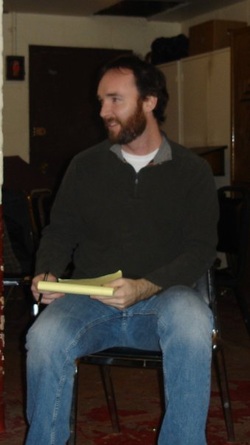Ric Sechrest as Educator

PROFESSIONAL AFFILIATIONS
Actors Equity Association (AEA)
American Federation Television and Radio Artists (AFTRA)
Screen Actors Guild (SAG)
Phi Kappa Phi Honor Society
Founding Company Member, Director – Living Classics Theatre (2007)
Company Member, Director/Actor – Retro Productions (2006 – present)
Company Member, Actor – Nomad Theatrical (2003 – present)
COURSES TAUGHT
Introduction to Acting (Major): As the first course in an Acting Course Track, introduce theater major students to the foundations of acting through the use of exercises, assignments, scene study, character analysis and comprehensive method study utilizing a variety of methods. The emphasis on the course is the discovery of the body as the acting tool.
Introduction to Acting (Non-major): Introduce non-major students to the foundations of acting techniques through the use of exercises, assignments, monologue and scene study, play attendance and written assignments.
Voice & Speech: This course has numerous segments, including introducing students to the masters of voice and relaxation and their techniques: such as Linklater, Skinner, Lessac and Fitzmaurice to name a few. Students will learn the importance of power and range, coloration of text in various styles as well as to adjust their voice for camera and voice-over work.
Movement for the Actor: This course emphasizes the importance of the student’s awareness of the body and its multiple functions on stage and in performance venues. It encourages the exploration of many techniques founded by numerous movement pioneers including Grotowski, Lecoq, Decreaux, and Laban. Some of these techniques would include working with elements, kinesthetic, clowning, and mask work to name a few.
Acting for Film or Multi-Media: After students have completed the basics of mind, body, and voice work in acting, they then learn, in this course, the ability to “adjust” it for the various mediums. This would involve using video, film, voice-recorders as well as digital projectors and power-point presentations along with any new technology introduced.
Business of Acting: This course teaches a student how to market themselves as professionals in the best light possible using all the available means. From finding a headshot photographer to posting a reel on You Tube, from networking to getting the work, the possibilities are unlimited, some are even unexplored. The student will learn to market themselves based on their definition of success. The opportunities in this business are endless. When you can’t find the work, you create it.
Introduction to Play Production: From the page to the stage advise undergraduates how to write, select, cast, direct, budget, promote, and produce a play.
Other Courses Qualified to Teach:
Voice and Diction (Major)
Arts Administration Dramaturgy
Graduate Research
Period Styles
Graduate Directing
Acting Shakespeare
Mime, Acrobatics, Movement
Actors Equity Association (AEA)
American Federation Television and Radio Artists (AFTRA)
Screen Actors Guild (SAG)
Phi Kappa Phi Honor Society
Founding Company Member, Director – Living Classics Theatre (2007)
Company Member, Director/Actor – Retro Productions (2006 – present)
Company Member, Actor – Nomad Theatrical (2003 – present)
COURSES TAUGHT
Introduction to Acting (Major): As the first course in an Acting Course Track, introduce theater major students to the foundations of acting through the use of exercises, assignments, scene study, character analysis and comprehensive method study utilizing a variety of methods. The emphasis on the course is the discovery of the body as the acting tool.
Introduction to Acting (Non-major): Introduce non-major students to the foundations of acting techniques through the use of exercises, assignments, monologue and scene study, play attendance and written assignments.
Voice & Speech: This course has numerous segments, including introducing students to the masters of voice and relaxation and their techniques: such as Linklater, Skinner, Lessac and Fitzmaurice to name a few. Students will learn the importance of power and range, coloration of text in various styles as well as to adjust their voice for camera and voice-over work.
Movement for the Actor: This course emphasizes the importance of the student’s awareness of the body and its multiple functions on stage and in performance venues. It encourages the exploration of many techniques founded by numerous movement pioneers including Grotowski, Lecoq, Decreaux, and Laban. Some of these techniques would include working with elements, kinesthetic, clowning, and mask work to name a few.
Acting for Film or Multi-Media: After students have completed the basics of mind, body, and voice work in acting, they then learn, in this course, the ability to “adjust” it for the various mediums. This would involve using video, film, voice-recorders as well as digital projectors and power-point presentations along with any new technology introduced.
Business of Acting: This course teaches a student how to market themselves as professionals in the best light possible using all the available means. From finding a headshot photographer to posting a reel on You Tube, from networking to getting the work, the possibilities are unlimited, some are even unexplored. The student will learn to market themselves based on their definition of success. The opportunities in this business are endless. When you can’t find the work, you create it.
Introduction to Play Production: From the page to the stage advise undergraduates how to write, select, cast, direct, budget, promote, and produce a play.
Other Courses Qualified to Teach:
Voice and Diction (Major)
Arts Administration Dramaturgy
Graduate Research
Period Styles
Graduate Directing
Acting Shakespeare
Mime, Acrobatics, Movement
